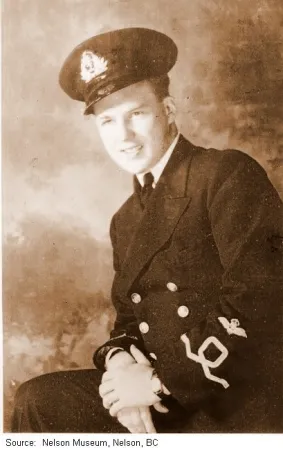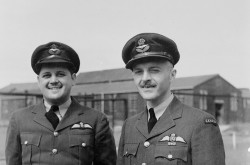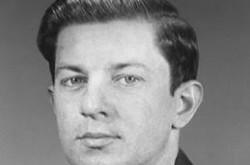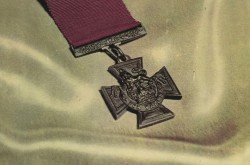Honouring the brave: Robert Hampton Gray was Canada’s last recipient of the Victoria Cross
Robert Hampton “Hammy” Gray was born in Trail, British Columbia on Nov. 2, 1917. His family later moved to Nelson, British Columbia, where he completed most of his schooling before attending the University of Alberta. Eventually, Gray transferred from the University of Alberta to the University of British Columbia to pursue pre-med studies. Gray took his academic career decently far before deciding to leave that life behind to enlist in the Royal Canadian Naval Volunteer Reserve in 1940. That September, Gray was chosen to sail to England — along with 74 other recruits — to attend pilot training at a facility called the HMS Raleigh.
While he served with distinction wherever he went, what he did between August 1943 and the combats in the Pacific of 1945 truly showed the world what Gray was made of.
Gray was trained to be a fighter pilot as part of the Royal Navy’s aerial combat unit, known as the Royal Navy’s Fleet Air Arm. In 1941, after completing his second round of training back in Canada, he graduated and achieved his goal of becoming a full-fledged pilot. After becoming a certified pilot for the Royal Navy’s Fleet Air Arm, Gray travelled all over the world. He was posted to East Africa and the Pacific front during the latter half of the Second World War. For a time, Gray was stationed in South Africa with the 789 Squadron. After being sent back to England, Gray was assigned to the aircraft carrier HMS Illustrious, followed by the HMS Formidable. At this time, Gray was flying a Vought F4U Corsair, which was designed to be used off aircraft carriers. Gray was now fighting against German vessels, where he would see his first bit of real combat. While he served with distinction wherever he went, what he did between August 1943 and the combats in the Pacific of 1945 truly showed the world what Gray was made of.
The act of bravery

In addition to the other memorials that have been dedicated to him, Gray’s likeness is one of 14 memorials lining a walkway in downtown Ottawa.
Even before earning the Victoria Cross, Gray proved himself as an exceptional fighter pilot. He was one of the pilots who, on July 28, 1945, sank an escort vessel which had run aground after being severely damaged by a U.S. Navy aircraft on July 25. For this act, he was awarded the Distinguished Service Cross.
Soon afterwards, Gray was chosen to lead a mission where he would ultimately perish — but not before completing his objective. On Aug. 9, 1945 Gray led eight Corsair fighter planes departing from the HMS Formidable to bomb Matsushima airfield, which had previously been targeted and was thought to be out of commission. Gray was to fly to the airfield and either attack or confirm the damage and choose another target. The Japanese ships that he had spotted docked in Onagawa Bay — located in Honshu, the main island of Japan — seemed like a fair target.
The fighting during this period of the war was especially fierce; the United States had just dropped the first atomic bomb on Hiroshima and the Japanese forces were not expected to surrender any time soon. The Japanese vessels below were expecting an attack. Almost immediately after initiating the assault, Gray came under heavy enemy fire and his aircraft was severely damaged. Gray was hit by the enemy anti-aircraft fire and one of his bombs was shot off without exploding, leaving him with only one to drop. Gray remained ever focused on his objective, and was able to drop his remaining bomb on a Japanese escort ship which sank within minutes. Shortly afterwards, Gray’s aircraft crashed into the water below. Despite losing Gray, the bombing run was successful. The other aircrafts involved were able to drop all remaining bombs, which sank several more ships and severely damaged the other Japanese ships in the bay. The Japanese forces that did survive spoke of the display of valour the Commonwealth pilots showed in the attack.
Linking Canada and Japan
Gray was awarded the Victoria Cross posthumously, and was the first Royal Canadian Navy serviceman to receive a Victoria Cross. In 1989, because of his true act of bravery, he was even honoured by the local townsfolk with a monument at Onagawa Bay. In August 2012, a new monument was unveiled to honour Gray after the original was damaged during an earthquake.

A plaque accompanies the memorial in Ottawa, in tribute to Gray’s military career.
Gray’s story has spawned a new relationship between the communities of Onagawa Bay, Japan and Nelson, British Columbia. For several years, Onagawa Bay has sent student delegations to Nelson. In addition, Gray’s name has been used to honour many different kinds of memorials in Canada. There’s a mountain in Kokanee Provincial Glacier Park, British Columbia, that carries his name (Gray’s Peak). The 81 Hampton Gray, VC Royal Canadian Sea Cadet Corps in Nelson also took his namesake.













![A block of photographs showing some of the people involved in the bombing of beluga whales in the estuary and gulf of the St. Lawrence River. Anon., “La chasse aux marsouins [sic]. » Le Devoir, 15 August 1929, 6.](/sites/default/files/styles/thumbnail_7/public/2024-09/Le%20Devoir%2015%20aout%201929%20page%206.jpg?h=584f1d27&itok=TppdLItg)






